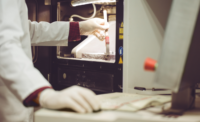When we board a train, cross a bridge or enter a shopping mall, we rarely stop to worry whether the structure is sound. Thanks to the inspection industry, we now take safety for granted.
Nondestructive testing (NDT) is the ‘unsung hero’ of the modern world, only coming into the limelight when there is a high-profile failure such as an air crash or a fairground-ride accident.
We all know that it is safer to fly on an aircraft than to cross a road or drive a car, but we have failed to grasp the role that NDT has played in that. While global passenger miles have increased rapidly, fatal accidents have decreased so there is now only one fatality per 8 billion passenger miles. NDT is not solely responsible for the steady improvement in safety, but it is largely the reason that it has been achieved affordably and reasonably delay-free for passengers.
NDT and the associated disciplines of structural health monitoring (SHM) and condition monitoring (CM) not only enhance safety—they can also reduce costs and improve performance. NDT can determine if a component is performing its required structural role through in-service inspections, help prove it at the design stage (certification), ensure manufacturing conformance to design (process control and quality control) and reduce risk to allow more efficient structural designs.
New inspection techniques are opening up new possibilities. The use of CM now allows data from aero engines to be streamed back to a control center while the engine is in flight, enabling early identification of precursors to faults and triggering maintenance in the next airport that is adequately equipped. Similar monitoring is performed on wind turbines.
Looking to the future, NDT will have an even bigger role to play. NDT will make greener air, land and sea travel possible and affordable by increasing confidence in structural design, allowing lighter-weight structures and reducing fuel consumption.
It will also play a central role in the fourth industrial revolution or Industry 4.0. The use of artificial intelligence and machine learning to process big data from the internet of things will lead to the tracking of component life using the ‘digital twin’ concept. One of the principal types of data used will be information from NDT, SHM and CM received via installed sensors.
Meeting the challenges
Of course research is essential to develop new inspection techniques and enable the introduction of these game-changing technologies. The UK Research Centre for Non-destructive Evaluation (RCNDE) is a consortium of academic and industrial members focused on the inspection technology needs of the 21st century.
We have run workshops and produced reports to identify the requirements of different sectors. Our industrial members have drawn up a collective vision over five, ten and 20-year horizons. Peter Thayer of the NDE Research Association (NDEvR), which represents their interests, agrees that views of NDT are changing.
He says, “Inspection technologies provide key capabilities underpinning many industrial sectors. NDT and monitoring is sometimes a necessary element of a sector’s operations, but it is increasingly being recognized as an opportunity to improve performance and profitability in sectors where the drivers are not simply statutory obligations.”
He says members—who include the likes of Airbus, BAE Systems, EDF Energy and Hitachi—recognize that further advances have to be planned and funded, so having a collective view of future requirements is important.
“Whilst each sector may have a different set of reasons demanding the use of NDT, the challenges and requirements are often shared across two or more sectors, which makes NDT an excellent opportunity for cross-sector research collaboration,” he adds.
Members have identified a number of common challenges: developing inspection techniques for high-value manufacturing processes such as additive manufacture; new engineering designs such as light-weighting for aerospace or renewable energy plants; new materials including composites and nano-materials; and new operating conditions, for example, deep water or radioactive environments.
There is also the problem of dealing with ageing infrastructure, whether it is power plants, oil and gas structures or aircraft, and where improved inspections could provide significant safety and economic benefits.
However sectors also have specific challenges. Here are some of the trend we are seeing, based on intelligence gathered at our workshops and from our industry members:
Aerospace
The sector leads the way in high-performance structural materials but life-cycles are long, certification processes are comprehensive and costly, and environmental targets for light-weighting are challenging. Whilst NDT is used extensively for structural-integrity inspections, the sector could further benefit from its use in the design and manufacturing stages to create more efficient, lighter-weight designs.
There is also a strong imperative to reduce inspection costs and aircraft downtime, which demands faster inspections, new techniques to inspect new materials and find ever smaller faults to fulfil the society’s expectations of safe air travel.
Automotive
While NDT has been widely used for high-performance ‘super-cars’ and motorsport due to the performance enhancements it offers and the high value of components, mass manufacturers have relied on it only for specific production problems such as for quality control of spot welding or adhesive bonding. Solutions are then automated and implemented on production lines.
However the move to electric vehicles is driving a step change. Whilst there is potential for improved battery efficiency, the biggest increase in fuel efficiency will come from light-weighting. Even mass-produced cars will contain significant amounts of composite material which will change design, production and in-service inspection requirements.
Marine
Whilst the marine sector has traditionally used NDT to meet safety standards and ensure cost-effective maintenance, the use of new materials is driving demand for new techniques. Our recent workshop on marine composites identified a wide range of requirements. Some of the issues can be solved by improved leadership and a working group is being established to achieve these training, certification and standardization objectives. However, others require technological solutions and will only be resolved by the industry engaging more closely with the NDT community.
Nuclear
NDT plays a central role in the supply of energy in any modern industrial society. Nuclear energy rightfully demands the highest standards of safety, and require inspection of components and plants throughout their lifecycle. Once again, materials offering the desired performance can have particularly demanding properties that push the capabilities of NDT, and are strong drivers for research. As hazardous environments demand remote operations, the industry is also increasingly drawing on newly-available robotic techniques.
Wind and renewables
Renewable energy relies on low-cost, large-scale, and numerous distributed power production facilities. The drive to lower the costs means, for example, huge offshore wind turbines which test the limits of engineering materials, and are expected to operate almost continuously for 25 years in the hostile marine environment. Such facilities are often remote and difficult to access and require very large area inspection coverage at a low cost to ensure economic operation. Trends include new developments in composite inspection, robotic delivery and the use of permanently installed sensor networks.
Industry 4.0
The Fourth Industrial Revolution is happening all around us, from self-driving vehicles to ‘healthcare’ robots and the transformation of industry and infrastructure. With the trend for ever more products and systems being connected to the internet of things, NDT will be impacted by Industry 4.0 and will also be an enabler for the transition, with embedded sensors providing some of the data necessary.
Despite its critical role it has played in industry and in our daily lives, NDT has traditionally operated behind the scenes. Perhaps it is now time for it to come into the spotlight.


